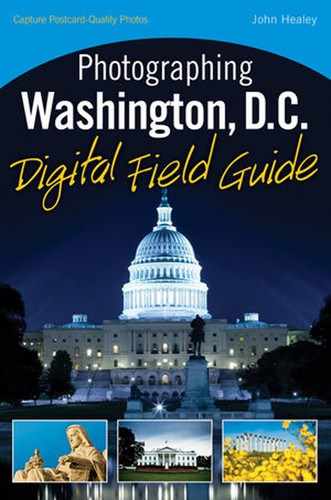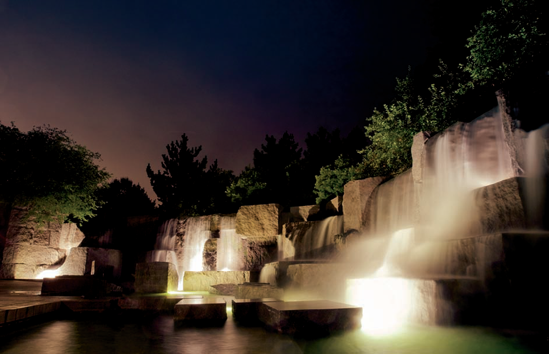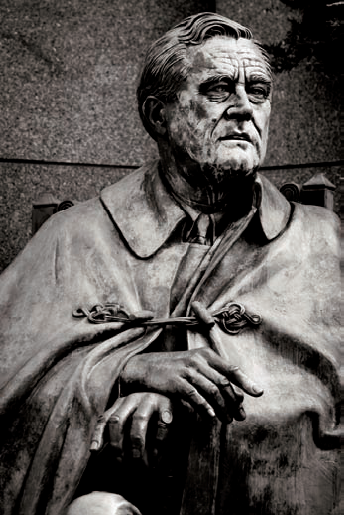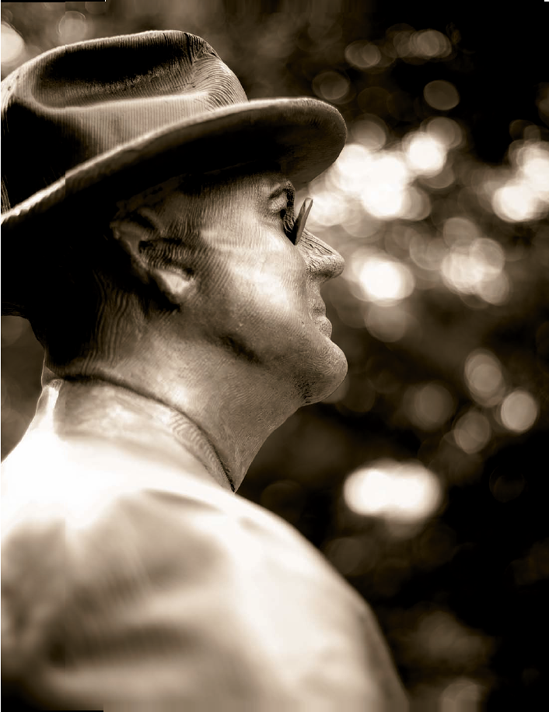
A portrait of Franklin D. Roosevelt's statue by sculptor Robert Graham at the beginning of the memorial. Taken at ISO 100, f/1.4, 1/200 second with a 65mm lens.
President Franklin Delano Roosevelt was the United States' thirty-second president, elected in 1932 at the nadir of a financial catastrophe that forever defined American history, the Great Depression. His persona, leadership, and the era in which he governed are all represented through artwork, waterfalls, trees, statuary, and quotations organized into four "rooms" of the memorial on a total of 7.5 acres. The rooms represent his unprecedented four terms in the office of President from 1933–1945.
The FDR Memorial isn't one that is overtly photogenic like the Jefferson and Lincoln Memorials. It is much more subtle in nature and built in a way that inspires contemplation rather than all-out awe. Two of the greater shocks to humanity of the twentieth century, the Great Depression and World War II, are events that shaped this time, and the somber and reflective tone of this memorial reflects that period.
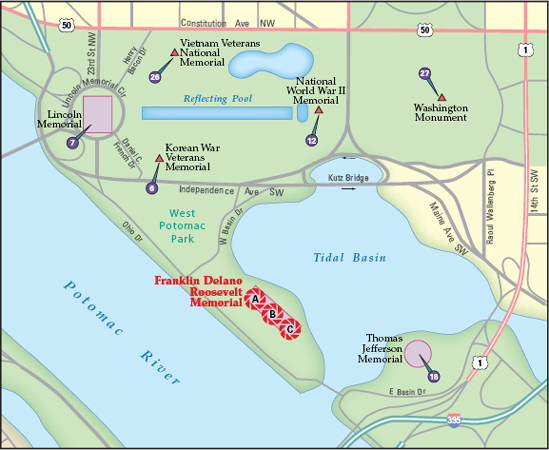
Figure 4.1. The best locations from which to photograph the Franklin Delano Roosevelt Memorial: (A) Room 2, (B) waterfalls in Room 3 and Room 4, and (C) Neil Estern's FDR statue. Nearby photo ops: (6) Korean War Veterans Memorial, (7) Lincoln Memorial, (12) National World War II Memorial, (18) Thomas Jefferson Memorial, (26) Vietnam Veterans National Memorial, and (27) Washington Monument.
Unlike other landmarks in the area that are mammoth in size, the FDR Memorial's intimate setting poses quite a different photographic challenge.
George Segal created The Breadline for the FDR Memorial in 1991. Segal was part of the Pop Art movement along with Roy Lichtenstein and Andy Warhol. You can see his other iconic public sculptures in areas such as the Golden Gate Park and the Port Authority Bus Terminal in New York.
It's a rather immediate reaction for tourists to line up with the men and take snapshots of themselves. While this is tempting, it seems to all but obfuscate the very serious and somber demeanor of the artwork. The weather and tourist-polished bronze figures both soak up and reflect light in a beautiful manner and are eminently photographable, as are all of Segal's sculptures in this room (see Figure 4.1).
War dominated President Roosevelt's third term in office. The loud, crashing water hammering chaotically placed boulders reflects the stresses of World War II on the world, the country, and the President himself in Room 3 of the FDR Memorial (see Figure 4.2). At the end of the memorial, a larger waterfall in front of a wide open space allows visitors to pause and think about what it represents: This was a time in U.S. history that was filled with unprecedented turmoil as well as significant forward progress.

Figure 4.2. Room 2 of the FDR Memorial at night (see A on the map). Taken at ISO 3200 f/2.8, 1/6 second using a 24mm lens.
The waterfalls were created both for their symbolic nature as well as the memorial's proximity to the landing path of Reagan National Airport. The waterfalls help to drown out the whine of the aircraft.
The FDR statue in Room 3 is larger than life but in a scale that lets a viewer enjoy the detailed precision of the art work and feel as if you are standing in a room with him. His commanding presence is offset somewhat by his dog, Fala, sitting obediently to his side (see Figure 4.3).
Photographing the statue here gives you a choice: You can create a simple record of what you saw — Roosevelt with his dog — or you can focus on the subtleties and create a portrait from the shadowy, intricate details that Estern carefully imbued into his artwork. Roosevelt's sculpted hair, the lines on his forehead, the manner in which his fingers drop — there's much to take in.
At the FDR Memorial, plan on spending some time taking in its symbolism as well as how to best compose your image. You may want to sit down and watch as people drift in and out, and consider different compositions and interpretations of the site.
A trip here requires more of an investment in composition and using the light to your advantage than a multitude of lenses or other gear.
For the photograph in Room 2, (refer to Figure 4.1), you can shoot it a variety of ways: close and with a wide lens, using a normal focal length lens, or farther away with a longer lens. When changing focal lengths, be sure to experiment with a variety of positions with each focal length. And try to get out of the habit of standing a standard distance and height from your subject. For example, what does the scene look like from very low? Or can you make the shot more interesting by including a foreground element by standing farther away? Also experiment with horizontal and vertical photos as well.
When photographing the waterfalls (refer to Figure 4.2), getting in close and using a wide lens creates a sense of "being there" (and will also risk getting you and your camera a bit wet — having a small towel with you can help). If you don't have a wide-angle lens you can always do a tighter version, focusing on a graphically elegant part of the waterfall.
Typically, longer focal length lenses are best for portraits (the standard portrait lens often refers to an 85mm focal length), and at the FDR Memorial it is a good idea to start with such a lens when photographing statues. Try to use longer lenses to clean up the background (the longer lenses make it easier to drop the backgrounds out of focus) and to focus on elements of the statue. Even though they aren't living people, there is little difference between them and a living person when you're photographing — other than a statue's unparalleled patience.
With a lot of images, a polarizer or neutral density filter is a good idea. Here, a basic, protective filter over your lens can help shield your lens from water spray. The standard UV protecting filter is an especially good idea when you are around water because it keeps moisture from landing on the front of the lens.
For nighttime and when photographing the water at slow shutter speeds (to get the "flowing" effect), a tripod is necessary (refer to Figure 4.2). However, during peak periods the guards often do not allow full-size tripods to be used, but there are a variety of places where a small, table-top tripod is perfectly suitable. When using a tripod, please be aware of other visitors and if asked by park police to not use it, you should of course respect their request. Instead, plan to return late or at night or early in the morning when few or no visitors will be there.
Tip
Buses often unload throngs of tourists, and those tourists are often only there for a few minutes before they are whisked away to the next stop. A few minutes of waiting may be all you need for more space.
During the day, use your camera's Aperture Priority mode to set a wide aperture, such as f/4 to minimize background distractions when photographing statues and artwork. When shooting with wide-angle lenses and close to subjects, set a higher aperture and focus on something that is slightly in the foreground. Doing so helps to get the entire photograph in focus.
If you want the cool, slow-shutter speed waterfall photo, be sure to acquaint yourself with how to set such shutter speeds beforehand. If you use Shutter Speed Priority mode, keep in mind that your camera may set a very wide aperture at night and thus focusing will be more critical. To get around this, use your camera's manual setting if possible, or use Aperture Priority mode, and use a higher aperture value such as f/11 that causes your camera to automatically set a long shutter speed.
Setting your color balance is more important if you are visiting at night; during the day, most cameras' Auto white balance does a reasonable job, because the scenes are mostly neutral colors. At night, experiment with different white balance settings. The yellowish lights in the memorial give you the opportunity to use their color to your advantage to make a warm scene, or you can set your camera to its tungsten setting to whiten them to some degree.
Finally, at night the waterfalls are perfect candidates to be photographed using a high-dynamic range method(HDR). Your eyes can see an extremely wide range of light to dark tones, much more than a camera can record. What your camera is able to "see" is defined by its dynamic range. To get around this limitation of a camera, you can create multiple photographs of the exact same picture but vary each photo's exposure from very dark to very light.
By using software designed to do so, you can blend these photographs together to get around the dynamic range limitations inherent to a camera. To do this, you can use your camera's exposure compensation feature and step it from 3-stops underexposed in equal parts to 3-stops overexposed. If you do this in 1-stop steps, you will have three underexposed photographs, one normal exposure, and three overexposed photographs to work with afterwards.
The FDR Memorial is one where you can shoot in almost any weather and any light, and come away with something interesting.
The FDR Memorial sits in a mostly north-south orientation, which means morning and evening are times you can take advantage of the good light. However, cloudy days mean the memorial is evenly lit, which makes for wonderful light to shoot in, too. An overhead sun on a cloudless day presents some challenges regarding contrast and reflections, but try to use whatever light you have to your advantage.
For example, if it's overcast and there are subtle shadows, you can shoot tighter shots of the statues' heads; you'll be able to easily see detail in the shadows. But if the sun is direct, and overhead, you may want to show the entire scene of, say, Estern's FDR statue because the hard shadows show abundant textures and give depth to the entire artwork.
Oddly enough, this memorial can be great to shoot just before or after a rain. Just like movie sets use water-drenched streets to evoke a mood, so too will rain here. The rain-slickened rock glistens and reflects the statues and artwork and creates a completely different feel from a dry, sunny day — especially at night.
Here the difference between day and night is stark. Although a bit more challenging, night is an interesting time to photograph here, particularly to photograph the waterfalls. At night, the dark stone fades away and the artwork glows. You need a tripod, whether it be a small, portable one or a full-size model.
The published hours of the memorial are 9:30 a.m. to 11:30 p.m., but this is only when rangers are available to answer questions and give tours. The actual monument, like most monuments in Washington, D.C., is accessible 24 hours a day, seven days a week. If you are looking for fewer crowds at night, plan on going after 10 p.m. (earlier if it is off season).
The many bronze artworks at the FDR Memorial can be interesting to photograph in color or black and white. Experiment with close-up shots of such details that may go unnoticed by people otherwise. Consider composing your shot with people in it to add a sense of scale and interest to the photo. Finally, be sure to view the exhibits from positions other than your normal conversational distance — go extra close as well as farther away — and see what ideas come to mind for photographs.
Tip
Much of the artwork in the FDR Memorial is copyrighted. Commercial use of photographs requires the permission of the copyright holder, generally the artist of the work. See www.copyright.gov for more information.

